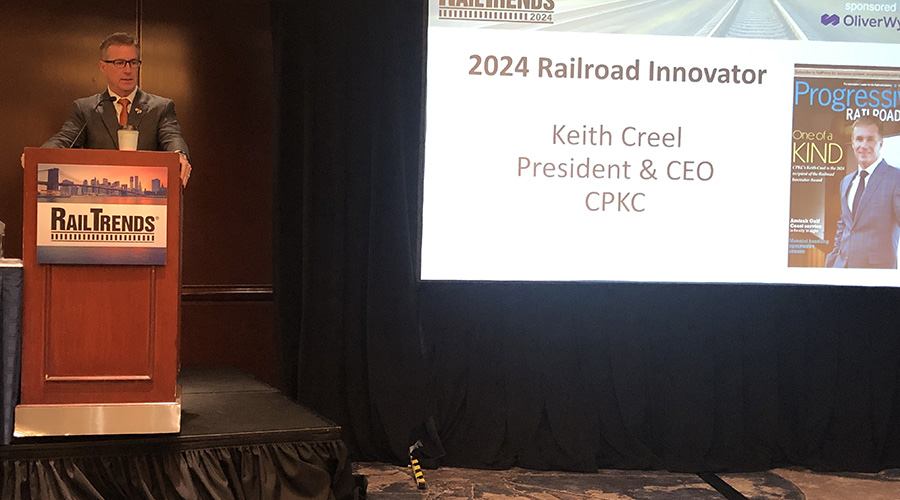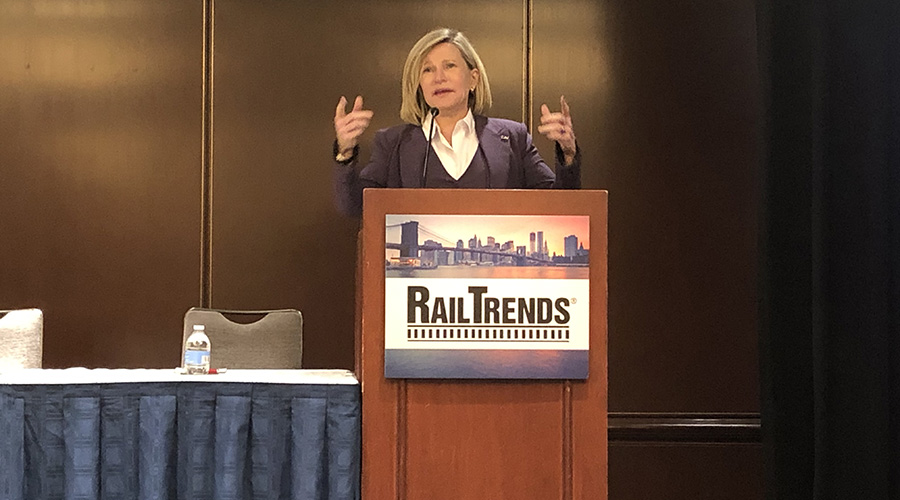Heard at RailTrends '24
11/20/2024
By Jeff Stagl, Managing Editor
The 20th iteration of RailTrends® held recently in New York City again drew a record crowd and again included a litany of compelling comments from speakers.
A meeting room at the New York Marriott Marquis remained packed Nov. 14 and 15 while 36 speakers who were part of 17 presentations shared valuable insights and — in certain cases — surprising anecdotes or newsworthy tidbits.
As is usual at RailTrends, the speakers ranged from CEOs and high-ranking officers at the Class Is to short-line executives to Surface Transportation Board members to major association presidents to industry observers and analysts to movers and shakers from the rail supply sector.
They covered a broad range of topics, including the economy, regulations, legislation, federal government leadership, labor, rail service, traffic growth, short line/Class I relationships, capital investments, trucking competition and technologies.
Following are paraphrased comments from a sampling of the 36 presenters at the event.
 Canadian Pacific Kansas City President and CEO Keith Creel now is the only two-time winner of Progressive Railroading’s annual Railroad Innovator Award. Jeff Stagl
Canadian Pacific Kansas City President and CEO Keith Creel now is the only two-time winner of Progressive Railroading’s annual Railroad Innovator Award. Jeff StaglHere’s a story you probably don’t know about. I got a call from former U.S. Labor Secretary Marty Walsh last year that the federal government was going to solve the paid sick leave issue for our employees if we railroads couldn’t address it independently. On the day of President Biden’s state of the union address on Feb. 7, 2023, Marty Walsh gave me a heads up that the president was going to announce seven days of paid sick leave for railroad workers unless we could show progress with the issue. I said to him, “Give me an hour.” I called the heads of the Brotherhood of Maintenance of Way Employes Division and Transportation Communications Union, actually got a hold of them, and worked out tentative agreements that we announced that night. So, that wasn’t a part of the state of the union address. This shows how we try to do things for CSX and the industry at the same time, and that our interests aren’t always independent.
— Joe Hinrichs, president and CEO of CSX
We are getting closer to the completion of the second span of the International Railway Bridge that links Laredo, Texas, with Nuevo Laredo, Mexico. Laredo is the busiest freight-rail gateway in North America and the single-largest point of entry into the U.S. — not the ports in Los Angeles and Long Beach. We recently decided to commission the bridge as the Patrick J. Ottensmeyer International Railway Bridge. Pat was a great friend and a passionate driver of the United States-Mexico-Canada Agreement that succeeded NAFTA. As the former leader of Kansas City Southern, Pat also was a major cog in the KCS-Canadian Pacific merger. There has been much discussion about possible tariffs being imposed by the new Trump administration. But I am much more encouraged than discouraged about the recent presidential election. We have a strong and provocative story to tell about this unique and unprecedented railroad.
— Keith Creel, president and CEO of Canadian Pacific Kansas City, and the 2024 winner of Progressive Railroading’s Railroad Innovator Award, which recognizes an individual’s outstanding achievements in the rail industry
 Tony Hatch (at far right) — program consultant for RailTrends — was part of the rail industry analyst panel, while Larry Gross (second from left) talked about the state of the intermodal market. Jeff Stagl
Tony Hatch (at far right) — program consultant for RailTrends — was part of the rail industry analyst panel, while Larry Gross (second from left) talked about the state of the intermodal market. Jeff StaglThe recent U.S. presidential election brings change. We are looking at possible changes at the agencies we care about. The Federal Railroad Administration (FRA) has been out of touch with innovation over the past four years. The FRA is where innovation goes to die. That’s frustrating. They need to try new ways and use data to help spur innovation. Technologies and innovations should be embraced and deployed. For example, there are opportunities to take more manual processes out of track inspection and automate it. It’s like the difference of you undergoing an MRI to check something out versus your doctor telling you that “you look fine” during an exam.
— Ian Jefferies, president and CEO of the Association of American Railroads
Sen. John Thune (R-S.D.) has been pegged as the replacement for longtime Republican majority leader Sen. Mitch McConnell (R-Ky.) in the Senate. If you would rank congressmen according to interest in rail issues, Thune would be No. 1. We’re not sure what percentage of his time will be spent thinking about rail issues, but his appointment is promising. The section 45G tax credit is a huge priority for short lines. We are seeking to raise the amount of the 45G cap from $3,500 per mile to $6,100 per mile and qualify more trackwork for the tax credit. There were two bills introduced this year as a warm-up act for that — the Short Line Railroad Tax Credit Modernization Act, H.R. 9522 and S. 5008. We hope similar bills get introduced in the new Congress next year.
— Chuck Baker, president of the American Short Line and Regional Railroad Association
The message we are putting out is we are safe, we rise to serve, we innovate for growth and we care for our people. How safe are we? A train can circle the equator 50 times until we have a derailment. All of us railroads have singular goals, but it’s important to all of us to drive growth. We all play hard and we all play clean and we all try to win — there’s nothing better. And we are winning with international intermodal business. Our international volume is up more than 30% over the past few months. We sell our network — we don’t just sell one location. We are selling a number of cities. And we aren’t just selling and winning intermodal. We are winning in bulk and ag and other areas.
— Jim Vena, CEO of Union Pacific Railroad
 CN leader Tracy Robinson characterized the Class I as running well with higher resiliency. Service now is more consistent on a day-to-day basis, she said. Jeff Stagl
CN leader Tracy Robinson characterized the Class I as running well with higher resiliency. Service now is more consistent on a day-to-day basis, she said. Jeff Stagl
We are convinced that improved service and the customer experience are the only way that railroads can increase shareholder value. There are three routes to growth for Class Is: intermodal, rail-centric development and short lines. Railroads need to be rigorous about real opportunities in intermodal. One opportunity is improving the interchange process for long-haul intermodal movements. Perhaps the largest opportunity is in capturing moves in the under-750-mile market. With short lines, Class Is need to elevate their short-line strategies to have more responsive processes and deeper collaboration. They should act as true business partners. The Class Is seem to be leaning into the three areas. The bad news is they aren’t yet addressing shippers’ core issues. Service performance simply isn’t good enough. Railroads must grow to take market share from trucks or there might be two major transcontinental railroad mergers in the future.
— Adriene Bailey, a partner with international management consulting firm Oliver Wyman, a diamond-level RailTrends sponsor
One of our pillars is operational excellence. We were missing consistent execution in the past. We are seeing more day-to-day consistency now and our scheduled operating plan is more resilient. In Canada, we dealt with serious wildfires in July and port labor disruptions in August, but in less than 10 days afterward, we were running back to normal. This is a railroad that’s running well and is resilient. We are casting our eyes forward over the long term — there is no short-sightedness, it’s 20/20 vision. We also need new eyes and expertise, and to grow our people. We need to evolve in the way we think about talent. The talent today is very mobile — they have a choice as to where to apply their skills. We can offer a lot with good jobs, high pay and great benefits. But we need to aim a bit higher and be more deliberate about building talent.
— Tracy Robinson, president and CEO of CN
I believe safety is the bedrock of a world-class rail operation and it will always remain central to our strategy at NS. Safety has got to be a value in every decision we make — it can’t be negotiated or re-prioritized. We had a problem with too many unscheduled train stops. A mechanical war room was established to drill down on each stop, whether locomotive- or car-related, and identify the root cause and fix problems at the source. As a result, train stops decreased by 18% in a matter of weeks. We are rebalancing the network, tightening down exceptions, eliminating deviation and creating more certainty, structure and repeatability. I’m energized by the performance we’ve demonstrated so far, and I’m even more excited about the opportunity that lies ahead. Our speak-up culture, safety summits, process rigor and discipline have been critical drivers of our early success and are foundational to progress in achieving our future targets.
— John Orr, executive vice president and chief operating officer for Norfolk Southern Railway
 CSX’s top executive, Joe Hinrichs shared an interesting anecdote involving President Biden’s state of the union address in February 2023. Jeff Stagl
CSX’s top executive, Joe Hinrichs shared an interesting anecdote involving President Biden’s state of the union address in February 2023. Jeff Stagl
We are fighting a flat industrial economy to grow. You have to love intermodal — it’s the obvious focus. You have to compete hard for business, be more efficient and have good service. We are performing better with service. Our velocity is up 14% and our dwell time is lower. We have had our highest velocity levels since 2016, and we set an all-time monthly intermodal volume record in October. And in September, we launched Shortline Select with Genesee & Wyoming’s Alabama & Gulf Coast Railway as the first participant. The Shortline Select program allows short lines to share our enduring commitment to growth and superior service by providing expanded opportunities for customers to reach an even broader consumer base. The program combines the benefits of short lines’ customized service with BNSF’s vast network reach. This week, we are announcing three more partners in Shortline Select: the Burlington Junction Railway, Texas North Western Railway (TXNW Railway) and Portland & Western Railroad. In 2025, we expect to expand the program even more.
— Tom Williams, executive vice president and chief marketing officer for BNSF Railway Co.
There is political uncertainty in Canada. The conservative party is leading in the polls for the next general election to be held in October 2025. We need provisions for the federal government to react more swiftly, such as to the recent port labor disruption. We need more tools in labor disputes. We also face the same challenges as the U.S. with getting the government to push for the early adoption of technologies. There is the fear that technologies can replace people.
— Marc Brazeau, president and CEO of the Railway Association of Canada
Will 2025 finally be the pivotal year for North American freight rail? Railroads are breaking the cycle of poor service. They need enough resiliency in their networks. Railroads need more time to improve service and grow — something short-term investors don’t want. We are in a freight recession led by trucks. But trucks will still grow more market share. There is a race between long-term and short-term investors, and I think railroads can win. I am a big believer in railroads building relationships with short lines. I think the opportunity to extend reach is a growth opportunity.
— Tony Hatch, independent rail industry analyst and RailTrends program consultant
The major intermodal themes in 2024 have been network resilience; a big surge in international volume on the West Coast; a slow-motion recovery in U.S. domestic volume; the suffering in Canada from repeated port labor disruptions; weak intermodal performance on the U.S./Mexico border; and strong domestic traffic in Mexico. But there is slippage coming in international volume — the same trends that have driven it are not there. The U.S. domestic market’s share ticked up in the third quarter. We expect a big surge in imports before inauguration day for Trump given his stance on tariffs. There could be slower growth with imports as tariffs bite, but that’s total speculation. Who knows.
— Larry Gross, president of Gross Transportation Consulting and an intermodal expert
 (From left) Rail association leaders Marc Brazeau, Chuck Baker and Ian Jefferies shared their views on the evolving political and regulatory climates in North America. Jeff Stagl
(From left) Rail association leaders Marc Brazeau, Chuck Baker and Ian Jefferies shared their views on the evolving political and regulatory climates in North America. Jeff StaglGenesee & Wyoming just had a second celebration — this time in Jacksonville — to mark our 125th anniversary this year. We have always focused on safety and service. The care of our people and our customers has carried us, but it won’t propel us over the next 125 years. You need to have the courage to embrace change and technology, and accelerate the pace of change. We also need to focus on the business principles that are timeless. To tailor service in the form of a relationship or partnership — you’re conducting business with a customer, it’s not just a transaction. The focus should be more on operating as an ecosystem to create more value for all participants.
— Michael Miller, CEO of Genesee & Wyoming Inc.
We have been working with a customer in the material business that is searching for a property on our Florida railroads for a new facility. Instead of finding an ideal site, it turns out the property housing one of our railroads is the best option. So, we are kicking ourselves out and looking for a new site for the railroad. We are in the final innings of making this work. As short lines, we need to advertise ourselves more broadly. We can create more momentum if we get people’s attention.
— Al Sauer, president and CEO of Regional Rail LLC


